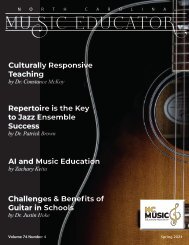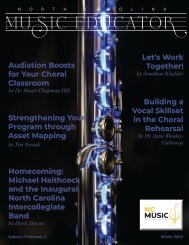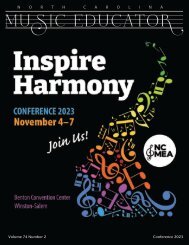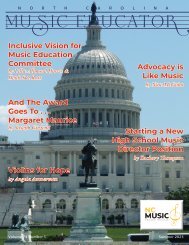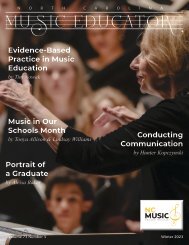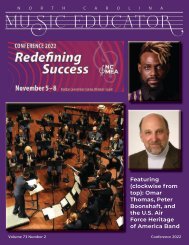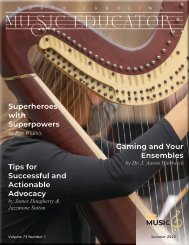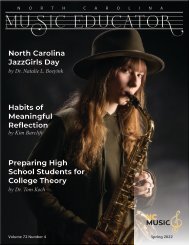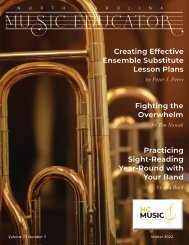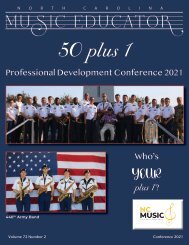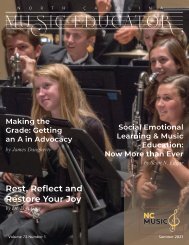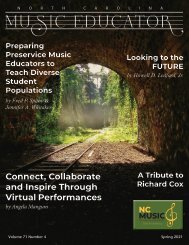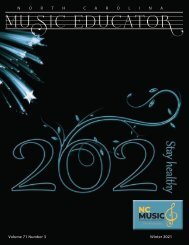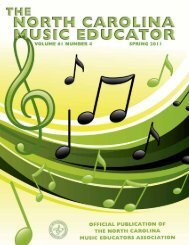NC Music Educator Winter 2017
North Carolina Music Educators Association Journal Winter 2017
North Carolina Music Educators Association Journal Winter 2017
- No tags were found...
Create successful ePaper yourself
Turn your PDF publications into a flip-book with our unique Google optimized e-Paper software.
in every aspect of their performance, fail to connect to the<br />
audience in a meaningful way. As Tom Carter explains, “When<br />
singers connect deeply and specifically to text and music, their<br />
faces and bodies are dynamically expressive, their singing is vibrant<br />
and nuanced, and – most significantly – their connection<br />
draws the audience into the heart and soul of the music” (Carter,<br />
n.d., para. 2). Therefore, how can choral directors bridge this<br />
initial gap in a non-threatening way for beginning performers?<br />
How can we help our singers understand the importance of<br />
connecting their faces, in a genuine way, to<br />
the words they are singing? Here are some<br />
examples of activities I have done with choirs<br />
and at workshops after watching “Face to<br />
Face.”<br />
How much do we depend on<br />
people’s expressions to understand<br />
dialogue or conversation?<br />
Sometimes students find it easier to discuss<br />
themselves in terms of their experiences<br />
with others. There is a section in “Face to<br />
Face” about a married couple who constantly<br />
argue, and a student with Asperger’s Syndrome.<br />
In both cases, the people involved do<br />
not understand how their faces cause reactions<br />
in other people.<br />
Quite frequently, people misread intent<br />
because of a mismatched facial cue. I encourage<br />
students to think about how this relates<br />
to choral performances. If the singer’s face looks bored, the<br />
audience is unconsciously receiving the message that this music<br />
is boring. I have students discuss the difference between acting<br />
like an emotion, and genuinely portraying that emotion. As a<br />
group, we list expressions that set people at ease or that make<br />
them uncomfortable, and practice singing with these different<br />
expressions on our faces.<br />
Do you use masking smiles? Do you use them<br />
while singing?<br />
Dr. Paul Ekman, of the University of California, San Francisco,<br />
describes the “Importance of a Smile” (Cleese & Erskine,<br />
2001). Specifically, he defines masking smiles as those used in<br />
contrast to a true smile of enjoyment. Masking smiles can fall<br />
into the following categories:<br />
• The “listener response” smile is one that encourages and<br />
indicates to a speaker that a person is engaged in the conversation.<br />
• The “polite smile” might be used when you receive a gift<br />
you would rather re-gift as soon as possible.<br />
• The “miserable smile” might be used when you get the<br />
news you are going to have a root canal, and it will likely<br />
hurt quite a bit.<br />
We sometimes use smiles to disguise how we feel. While<br />
30 | NORTH CAROLINA MUSIC EDUCATOR<br />
When singers connect<br />
deeply and<br />
specifically to text<br />
and music, their faces<br />
and bodies are<br />
dynamically<br />
expressive, their<br />
singing is vibrant and<br />
nuanced, and –<br />
most significantly<br />
– their connection<br />
draws the audience<br />
into the heart and<br />
soul of the music.<br />
these may be useful in order to spare people hurt feelings, do<br />
these kinds of smiles become a tool for us to portray happiness<br />
when performing music? The smile of true enjoyment is unmistakable.<br />
No matter how trivial, I ask participants to list those<br />
things in their lives that have created a true smile of enjoyment.<br />
From chocolate shakes to holding a newborn, the discussions<br />
have been one of the more positive moments in my teaching.<br />
Sharing what makes us smile helps performers form an internal<br />
reference to tap into during performance, creating an expression<br />
of true enjoyment rather than a masking<br />
– Tom Carter<br />
smile which may send a mixed message to the<br />
audience.<br />
If we simply sing music, without expressing<br />
a genuine idea of the intent of the music, are<br />
we sending mixed signals to an audience? Is<br />
that important?<br />
Though a choir is made up of many<br />
individuals, the audience can perceive the<br />
choir as one entity, and as such, expects to<br />
experience a homogeneous emotion from the<br />
entire group. What will the audience perceive<br />
if every member of an ensemble is sending<br />
different emotions or mixed facial expressions?<br />
Here is an exercise: take a small group<br />
of students and present them with scenarios<br />
to emotionally represent on their faces. Have<br />
the remainder of the group act as the audience<br />
and describe the emotion they are seeing.<br />
Five willing students are privately told to display the happiness<br />
they would feel if you offered to pay their college tuition. Then,<br />
privately ask some of the students to react as if Saturday will<br />
be a make-up day of school, and regardless of how they feel<br />
about that, they need to try to look happy. Ekman’s research on<br />
micro-expressions helps differentiate between a real expression<br />
of happiness and a faked expression of happiness. After a brief<br />
discussion about the differences, ask the students if they believe<br />
the experience could have a positive implication on their preparation<br />
for a future performance.<br />
As teachers, it is important to investigate our own comfort<br />
with displaying and discussing emotions with our students.<br />
Singing is a performance art, and the visual message we send as<br />
singers is just as important as the auditory one. Encourage your<br />
students to indicate personal strategies they can develop to reflect<br />
their understanding of their own facial expressions. I hope<br />
students and teachers understand expressions are part of a basic<br />
human condition and are relevant to all of us.<br />
There is a myriad of research available investigating how<br />
performers can best connect with their audiences. I continue<br />
to learn from research and from the people with whom I<br />
have these discussions. “Face to Face” and the conversations it<br />
helps generate, serves as a first, pragmatic step with my own<br />
choirs before we delve into character development. While the




